Better graphics.
For an index of all my Mac Pro articles, click here.
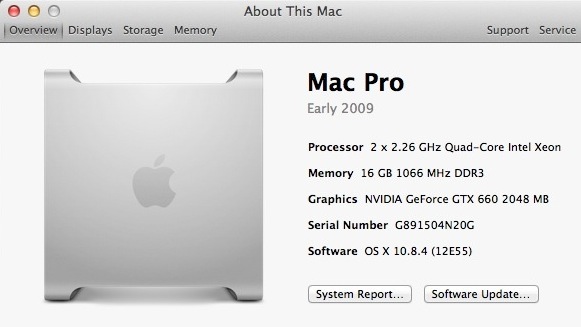
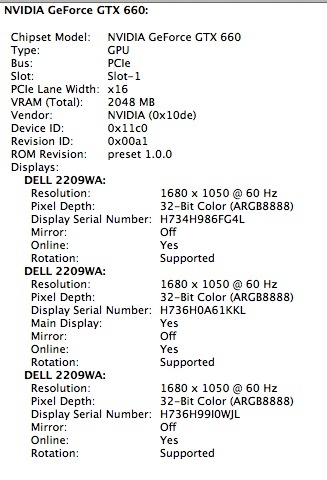
Where we are headed.
The stock card which comes with the 2009 Mac Pro is dated by modern standards. The GT120 is a slow performer and supports only two external displays, one using DVI the other Mini DisplayPort.
My goal was to transplant the Zotac nVidia GTX660 card from my Hackintosh to the Mac Pro and in practice the process proved to be easy.
First, however, as the GTX660 requires a separate power supply cable, I bought one of these from Amazon. You can pay MacSales three times as much for the same cable if you like. Disregard the ‘G5’ designation – this is the correct cable.
Here’s how it looks:
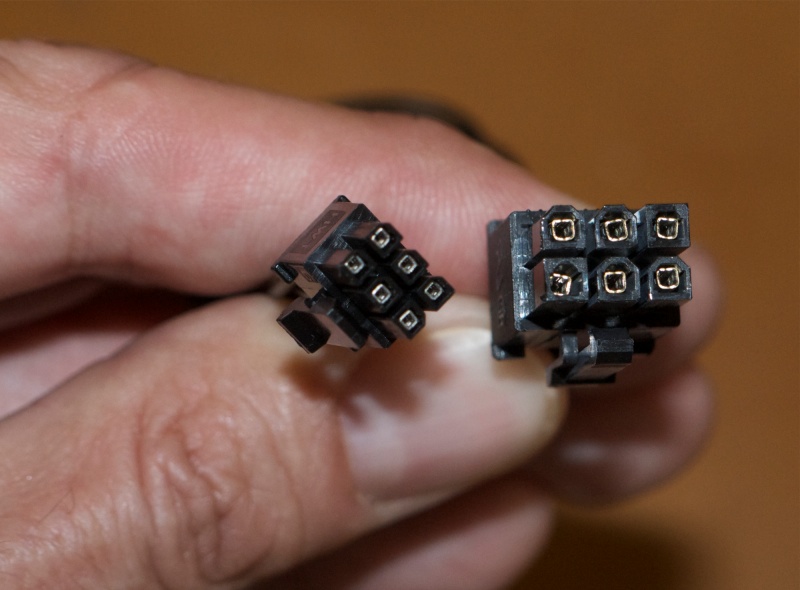
PCIe power cable. The small end goes
in the socket on the backplane board,
the large end plugs into the GTX660.
There are two backplane (motherboard) sockets in the Mac Pro. With the chassis oriented so that the PCIe slots go left-to-right in front of you, with their brackets on the right, these two sockets are found immediately to the left of the rear of the PCIe slot nearest to you and just to the right of the large, grey central fan, abutting the base of the processor cage:
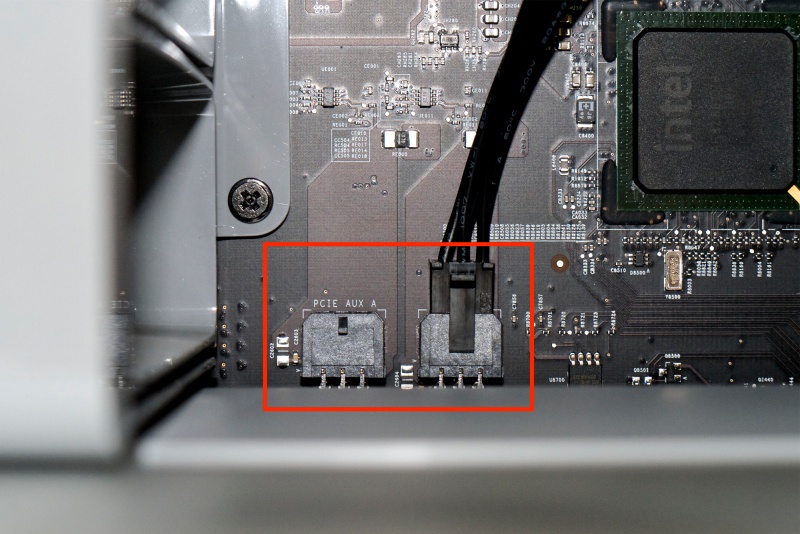
PCIe power sockets.
Undo the two thumb screws atop the PCIe brackets on your right and remove the existing GT120 card. Then remove the adjacent blanking plate:
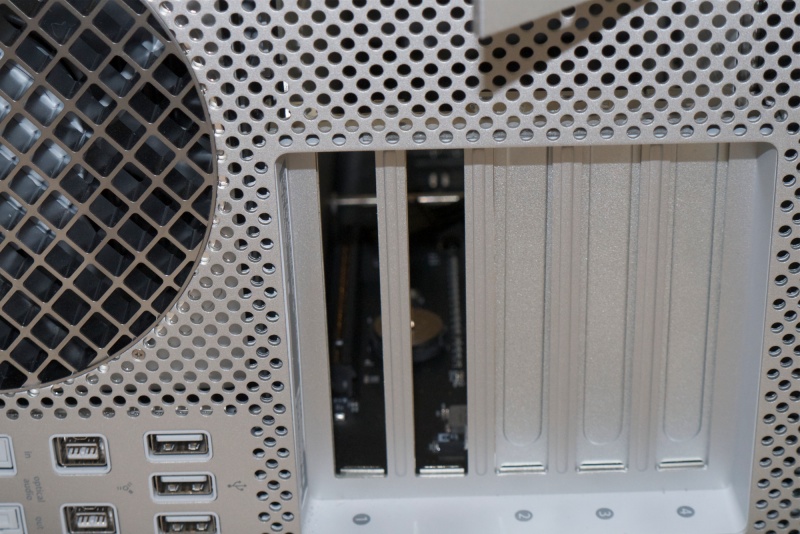
Ready for GTX660 installation.
The GTX660 is a double width card, so that second blanking plate must be removed.
Depress the slider button atop the central fan enclosure – this is generally referred to as the PCIe fan:
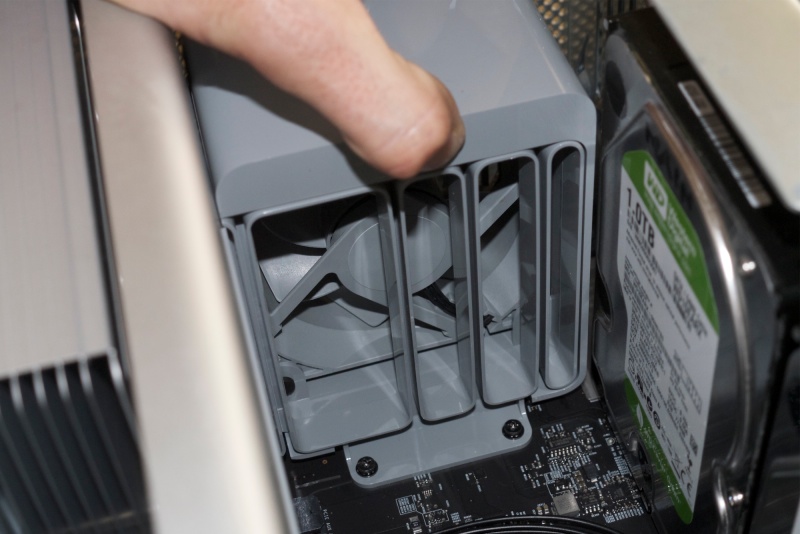
Button on the fan casing depressed.
With the button depressed the outer casing of the fan assembly can now be slid to the left. This moves the PCIe card chromium retaining bar to the left and allows insertion of a full length card:
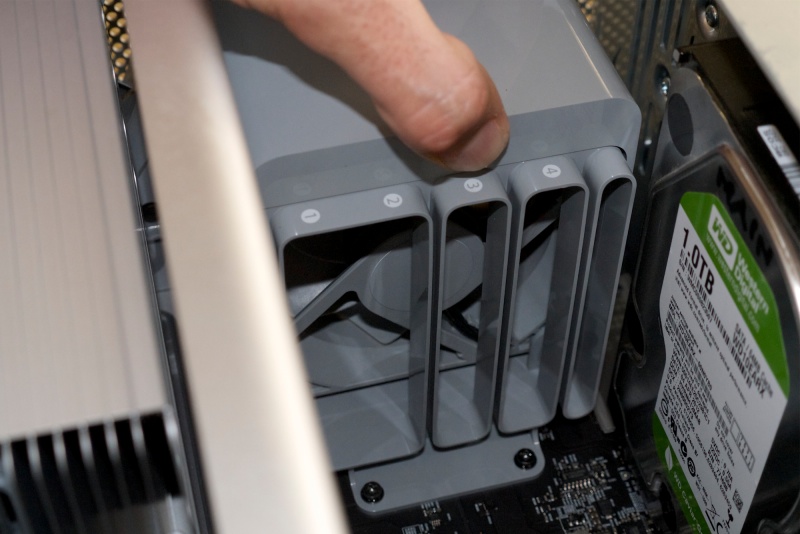
The fan casing/retaining bar have been moved to the left.
Insert the GTX660 card:
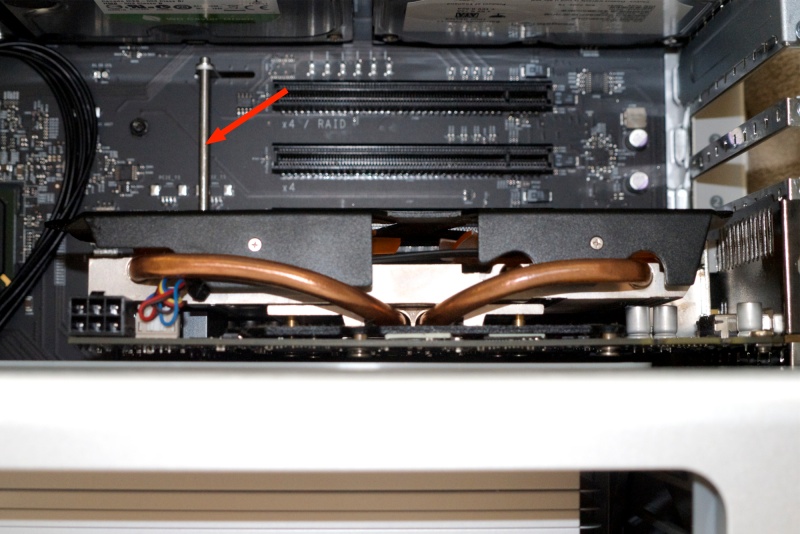
Graphics card inserted. Arrow denotes the retainer bar operated by the outer fan casing.
Check all is properly aligned:
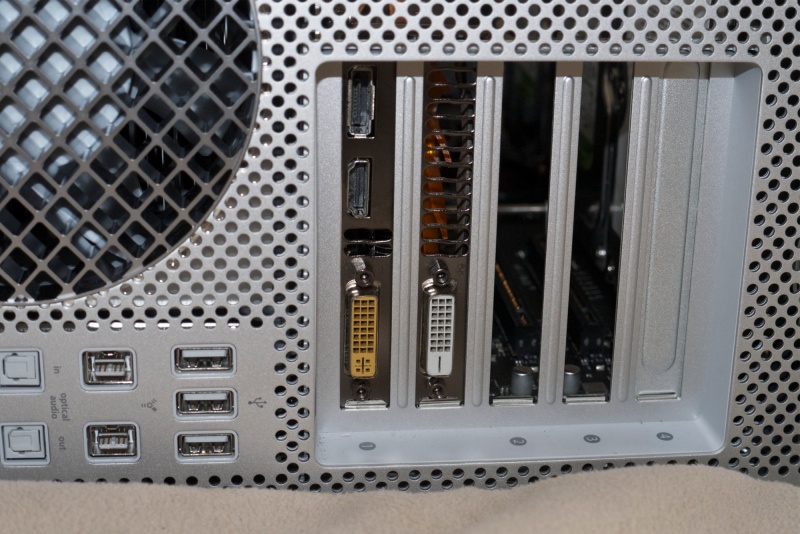
Graphics card sockets properly aligned. Orange = DVI-I; White=DVI-D.
27″ and 30″ displays must be connected to the white or orange DVI sockets
using dual-link DVI cables for maximum definition with displays which have
more than 1920 x 1200 pixels.
Insert the PCIe card retainer and tighten the thumbscrews. Then remember to slide the PCIe fan casing back to its original position, thus locking down the rear of the graphics card.
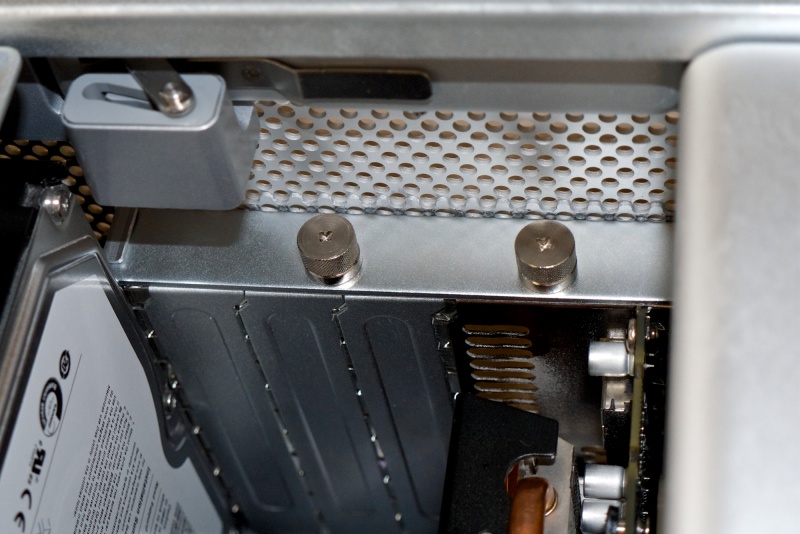
PCIe card retainer in place.
Insert the other (large) end of the PCIe power cable into the graphics card. The chassis has been flipped through 180 degrees here with the GTX660 sockets on the left, for clarity of illustration. Some later cards require that two power cables are used; the GTX660 needs one. The stock GT120 needs none.
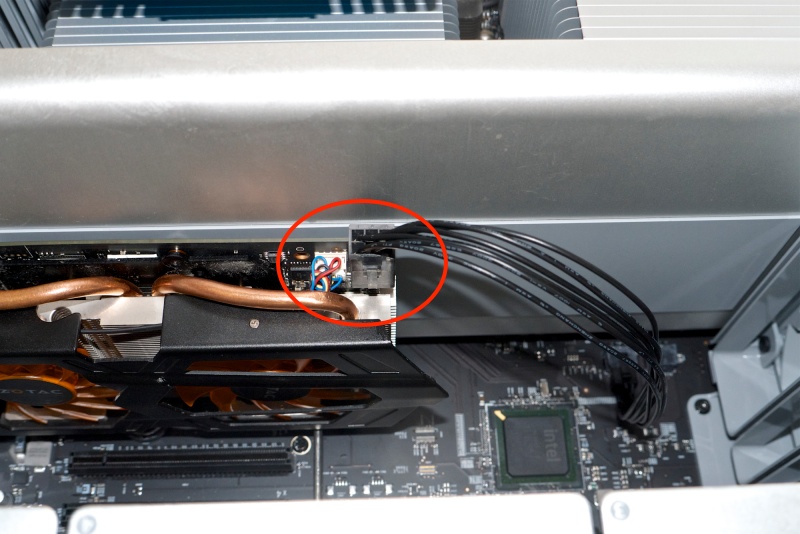
Power cable plugged into the graphics card.
Replace the cover, plug in all your cables and you are ready to go.
I use three Dell displays all with DVI sockets. The GTX660 provides four display sockets – DVI-dual link (for 27″ and 30″ displays as well as all smaller ones), DVI single link (all others except 27/30″), DisplayPort (not Mini DisplayPort) and HDMI. My displays are connected with two DVI cables and one DisplayPort->DVI cable.
How is it in practice?
Anomalies:
With Mountain Lion 10.8.4 (and 10.8.3) Apple started including nVidia drivers for this card as part of the OS. Any OS before the last version of Lion will not cut it with any GTX6xx series card. You must have late Lion or Mountain Lion. My Mountain Lion installation is plain vanilla, downloaded from the AppStore, and the card was recognized out of the box. I did not install any separate nVidia drivers. However, as the ROM in the card is not the officially sanctioned Apple ROM (the ‘Apple tax’ at work), you will lose the Apple-logo splash screen. After a period of blackness on restart, 25 seconds starting from an SSD drive, your display(s) will come to life with the login screen. The other anomaly is that common temperature monitoring tools will not display GPU temperature, another quirk attributable to the ROM.
The way around these anomalies is to fit a ‘Made for Mac’ version of a graphics card – the top end being the nVidia GTX680 ($500) and the Radeon 7950 ($480). Both are overkill for still photographers but great for video processing. The GTX680 is bumping up against the 300 watt limit for power supply from the backplane sockets, using 250 watts, so if you can live with it I would suggest the Radeon 7950 which comes in at 200 watts. You can see the comparisons here.
Another alternative is the Radeon 5770 which costs $250 in the ‘Made for Mac’ version. It is slightly slower than the $200 GTX 660. It can drive up to three displays (one DVI, two MiniDisplayPort), one of which can be 27/30″.
A workaround for the Anomalies noted above:
So the only thing a non-‘Made-for-Mac’ overpriced ($50-200 more for a couple of lines of changed code in the card’s ROM – highway robbery) graphics card has is that the Apple splash screen and spinning gear wheel are not seen at start-up. Often, it has to be added, the performance of ‘Made-for-Mac’ cards is slightly lower than that of the stock items for reasons known only to Apple. Using a non-‘Apple’ card, the system goes from a black display to the login screen in 25 seconds. There is no splash screen or spinning gear wheel. This is no impediment in practice. If you are doing a clean OS X. Stall, nothing is lost or invisible. If you are unfortunate enough to want to boot Windows from a BootCamp partition or separate disc, there is a utility which allows you to specify that partition or disc as the one to start from on reboot. You look it up – I do not use Windows.
Performance of the GTX660:
In a word, a lot better than the GT120 (hardly difficult) but not at the stellar level of the same card in the Hackintosh with an over-clocked Sandy Bridge i7-2600K CPU.
I cannot run the latest Unigine test app on the old GT120 (the card cannot cope) but here is the result with the Mac Pro – click the above link to compare with the Hackintosh:

Unigine graphics test – Mac Pro 2009.
Here, also for comparison, is Novabench:
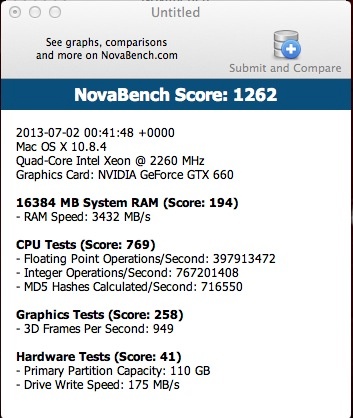
Novabench for the GTX660.
In summary, performance is 70-80% of that in the Hackintosh and of the order of twice as fast as the GT120.
How is it in practice with Lightroom and Photoshop?
Really no noticeable difference from the very fast Hackintosh. LR5 loads in 7 seconds, file-to-file Loupe review is faster than you can hit the arrow button (I use 1:1 previews). First entry to the Develop module is 6 seconds and 1-2 seconds thereafter. Flipping between images in the Develop module is instantaneous – which is why you install a card of this caliber in the first place.
Export to Photoshop CS5 is 3 seconds or less.
With its twin fans the GTX660 is an exceptionally quiet card, quieter than the stock GT120 and much quieter than the 9800GT which I used for a few days while awaiting the PCIe cable for the GTX660. It makes an already quiet machine near perfect when it comes to noise. 18″ from the front of the case the sound level was recorded at 45dB, compared with 44dB with the MacPro off.
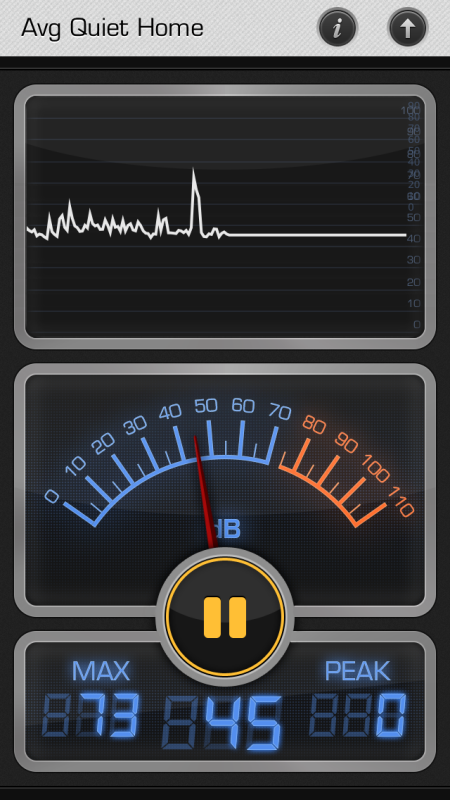
Noise. The 73dB spike is from a birdie tweeting outside my window!
The iPhone/iPad used above is named ‘Decibel 10th’ and is free in the AppStore.
Revised power consumption data:
With the GTX660 card in use with three displays and with the GT120 in the case but not connected to any displays, the static power consumption of the MacPro is 201 watts, excluding the displays. With the Mac Pro in sleep mode the power consumption falls to 10 watts. Moral: Put your Mac to sleep when it is not in use!
Each of my three Dell 2209WA 21.5″ 1680×1050 displays uses 44 watts, so with three displays the Mac Pro is using 333 watts/hour. Not trivial. The displays sleep when not in use as does the Mac Pro. A sleeping display draws no power.
nVidia web drivers:
After I had installed the far faster Intel Xeon 3.33GHz W5590 twin CPUs, it came to my notice that nVidia had made available new drivers on its web site. OS X Mountain Lion had started including nVidia drivers with 10.8.3 so I compared the web drivers with those which come with 10.8.4 which I am currently using. You can download the nVidia web drivers here. Once installed they add a System Preference pane thus:
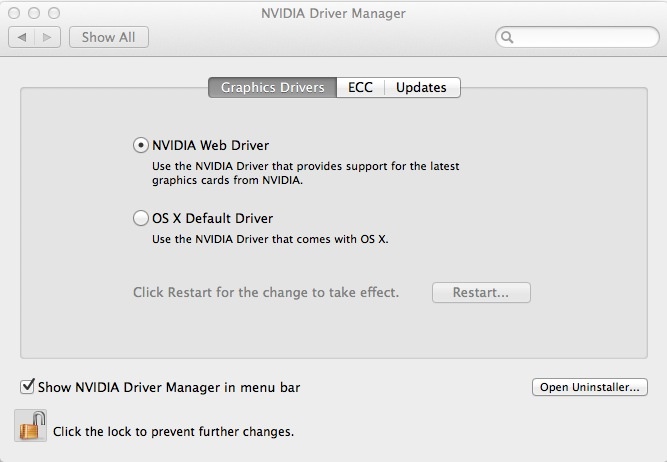
nVidia web drivers installed.
Running Unigine there is negligible difference:
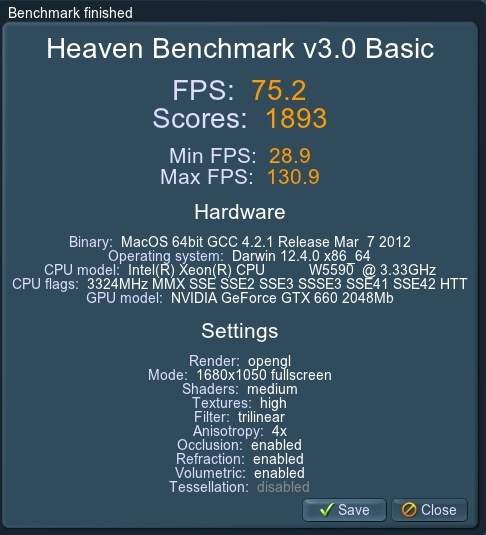
Native OS X 10.8.4 drivers.
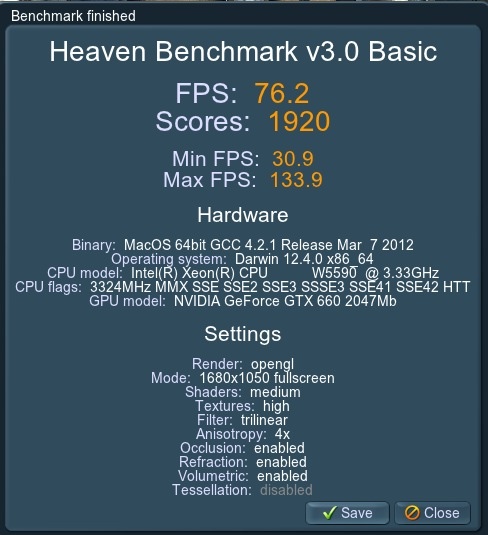
nVidia web drivers OS X 10.8.4.
The only thing learned here is that using a faster CPU does improve Unigine results – compare with the Unigine data above run with the stock Xeon 2.26GHz E5520 CPUs.
So why bother installing these? Well, in the event nVidia should update drivers part way through an OS X release, you will be able to install the improved drivers without having to wait for an update from Apple, so why not install them?
Conclusion:
The GTX660 (nVidia, Zotac, EVGA, MSI, PNY or any other brand) is a great enhancement to the stock GT120 card which shipped with the 2009 Mac Pro, but see ‘Anomalies’ above. The state of the art is to be had in the far costlier nVidia GTX680 or Radeon 7950 which, if bought in the ‘Made for Mac’ versions, will sidestep the anomalies noted.
Excelent Series of 2009 Mac pro articles. I recently bought a used Mac pro 2009 2×2.66 MHz CPU and I was wondering if it was a good decision. I could not have received better advice than yours in such a clear explanation!! Thank you very much for all the hints and precious information!!